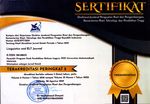Gamification: Using Kahoot! to Make Students Love the Class from the Very Beginning
Abstract
Keywords
Full Text:
PDFReferences
L. Zingg, “The Power of First Impressions,” teachforamerica.org, para. 1, Aug. 12, 2019. [Online]. Available: https://www.teachforamerica.org/stories/the-power-of-first-impressions [Ascessed Sept. 12, 2019].
Everly Center: Teaching Excellence & Educational Innovation, “Design & Teach a Course: Make the Most of the First Day of Class,” Carnegie Mellon University, 2019. [Online]. Available: https://www.cmu.edu/teaching/designteach/teach/firstday.html [Ascessed Sept. 12, 2019].
K. M. Kapp, The gamification of learning and instruction: game-based methods and strategies for training and education. Hoboken, NJ: John Wiley & Sons, 2012.
Kahoot!,”About Us: Mission”, Accessed on: Sept. 17, 2019. [Online], Available: https://kahoot.com/company
M. A. Ismail and J. A. Mohammad, “Kahoot: A Promising Tool for Formative Assessment in Medical Education,” Education in Medicine Journal, vol. 9, no. 2, pp. 19–26, 2017.
M.C. Prieto, L.O. Palma, P.J.B. Tobias and F.J.M.Leon, “Student Assessment of the Use of Kahoot in the Learning Process of Science and Mathematics,” Education Science Journal, vol. 9, no. 1, pp. 55-68, 2019
S. A. Licorish, J. L. George, H. E. Owen, and B. Daniel “Go Kahoot!!” Enriching Classroom Engagement, Motivation and Learning Experience with Games,” In Proc. International Conference on Computers in Education, 2017, pp. 755-764
S. A. Licorish, J. L. George, H. E. Owen, and B. Daniel “Students’ perception of Kahoot!’s influence on teaching and learning,” Research and Practice in Technology Enhanced Learning, 2018, doi:10.1186/s41039-018-0078-8
T.. T. T. Nguyen and T. Yukawa “Kahoot! with Smartphones in Testing and Assessment of Language Teaching and Learning, the Need of Training on Mobile Devices for Viatnamese Teachers and Students,” International Journal of Information and Education Technology, vol. 9, no. 4, pp. 286-298, 2019
D.J. Ary, L.C. Sorenson, A. Razafieh, Introduction to Research in Education. United States of America: Wadsworth, Cengage Learning, 2010.
“A ‘layman’s’ explanation of Ultra Narrow Band technology,” Oct, 2017. [Online]. Available: https://Kahoot!.com/files/2017/07/Kahoot!_guide_to_creating_and_playing_learning_games.pdf
. [Accessed: Sept. 17, 2019].
DOI: https://doi.org/10.31764/leltj.v7i1.1649
Refbacks
- There are currently no refbacks.
Copyright (c) 2020 Linguistics and English Language Teaching Journal

This work is licensed under a Creative Commons Attribution-ShareAlike 4.0 International License.
_____________________________________________________
Linguistics and ELT Journal
p-ISSN 2339-2940 | e-ISSN 2614-8633

LELTJ is licensed under a Creative Commons Attribution-ShareAlike 4.0 International License.
_____________________________________________________
LELTJ is abstracting & indexing in the following databases:
_____________________________________________________
LELTJ Editorial Office:













